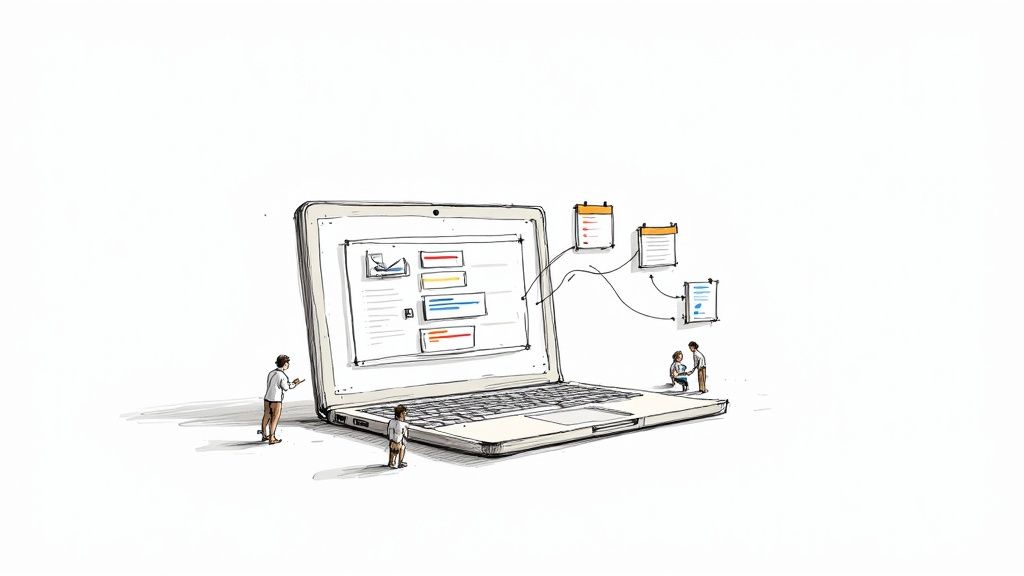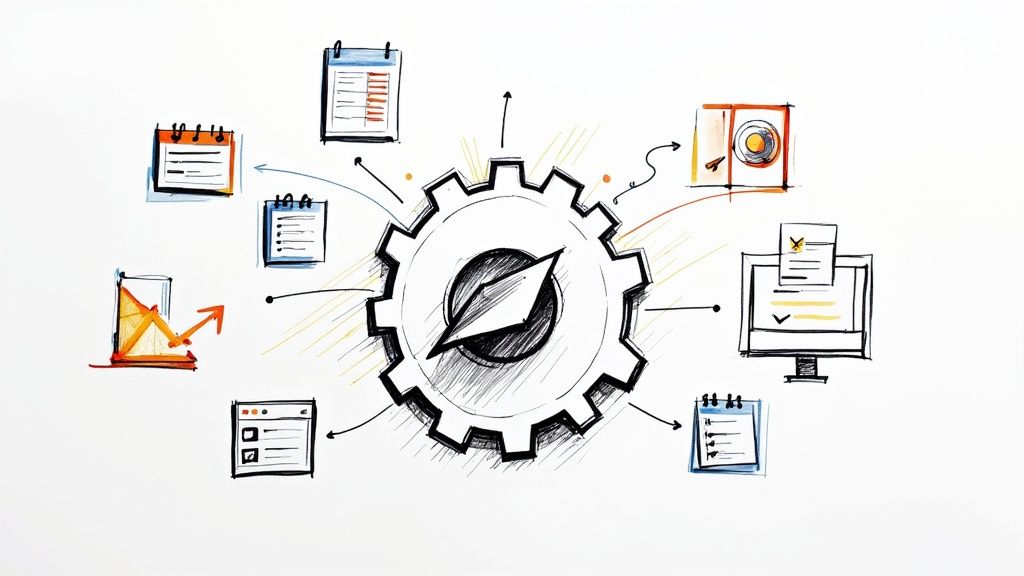
How to Improve Workplace Efficiency Today
Discover how to improve workplace efficiency with our guide. Learn proven strategies to streamline workflows, cut distractions, and boost team productivity.

If you want to improve workplace efficiency, it really boils down to two things: reduce friction and increase focus. It’s about getting rid of all those tiny, daily frustrations that sap your team's energy and giving them tools that let them do meaningful work, not just admin.
Why Workplace Efficiency Is Your Biggest Growth Lever

Let's be honest, inefficiency is a silent killer for your business, and it costs a lot more than you probably realize. This isn't just about lost hours on a timesheet. It's the ripple effect of disengagement, missed opportunities, and eventual burnout that puts a hard stop on growth.
When your team is bogged down, the best ideas die in a mess of confusing email threads and disconnected to-do lists. This digital chaos leads to a cycle of "work about work"—where everyone spends more time trying to organize tasks than actually doing them.
The Hidden Costs of Disengagement
One of the biggest red flags of an inefficient workplace is a drop in employee engagement. When the process is clunky and the tools don't talk to each other, people get frustrated, and their motivation nosedives. The latest data paints a pretty grim picture: global employee engagement has sunk to just 21%. That widespread disengagement costs an estimated $8.9 trillion in lost global GDP. You can dig into these findings from Gallup's extensive workplace research.
This drives home a critical point. Making things more efficient isn't just about getting things done faster. It’s about building a work environment where people feel empowered and genuinely connected to what they're doing.
An efficient workplace is an engaging workplace. When you clear away the operational roadblocks, you give your team the clarity and freedom to pour their energy into work that actually matters, which lifts both morale and your bottom line.
Shifting from More Tools to Smarter Solutions
The answer isn't to just keep piling more apps onto your team's plate. It's about making the tools you already rely on, like Google Workspace, work smarter for you. They can be more than just utilities; they can become the engine that drives your team's productivity.
This guide will help you reframe how you see efficiency—not as another chore on your list, but as the single most powerful lever you have for sustainable growth. We'll walk through actionable strategies you can put into practice right away to overhaul your workflows and unlock your team's true potential.
Escape the Trap of 'Work About Work'
Are your days spent hunting for that one file in Google Drive, toggling between a dozen open tabs, and sitting through meetings that really, really should have been an email? If that sounds familiar, you're stuck in 'work about work,' and it's quietly sabotaging your team's momentum.
This is the administrative quicksand that eats up the time and brainpower meant for high-impact projects. It’s the digital version of running on a hamster wheel—you feel busy, but you aren't making any real progress on the things that actually move the needle. This is a massive drain, with research suggesting many employees spend around 60% of their time on these secondary activities. If you want to dig into the numbers, ProofHub has some eye-opening findings on this productivity drain.
Reclaim Your Focus by Centralizing Your Work
The first real step toward better workplace efficiency is creating a single 'source of truth' for your projects. When information is scattered everywhere, your team is forced to constantly switch contexts, which drains mental energy and practically invites costly mistakes.
Think about a typical project. The design files are in one corner of Google Drive, crucial client feedback is buried in a month-long email thread, and the actual action items are scribbled on someone's personal to-do list. It's a recipe for pure chaos.
A much better approach involves a couple of strategic shifts:
- Structure Your Shared Drives: Don't just create a digital dumping ground. Build a logical, consistent folder structure that everyone on the team understands and actually follows. It's a simple change, but it drastically cuts down on the "Where did I put that?" scavenger hunts.
- Consolidate Conversations: Pull project-specific discussions out of those sprawling, endless email chains. Move them into a dedicated Google Chat Space where all communication, files, and decisions live in one organized, searchable spot.
Once you have everything in one place, you can start prioritizing effectively. This infographic breaks down a simple flow for turning a messy task list into a clear, actionable plan.
As you can see, the path from just listing tasks to actually categorizing and scheduling them helps you focus on what's truly important, not just what feels urgent in the moment.
True productivity isn’t about doing more; it’s about doing more of what matters. By cutting down the 'work about work,' you free up cognitive space for strategic thinking and deep work.
To help you get started, I've put together a table that shows some of the most common time-wasters I see and how you can solve them using the tools you already have in Google Workspace.
Common Time Wasters and Their Google Workspace Solutions
| Common Inefficiency ('Work About Work') | Google Workspace Solution | Potential Impact |
|---|---|---|
| Hunting for files and documents | Use Shared Drives with a consistent, templated folder structure for all new projects. | Drastically reduces search time and ensures everyone is working from the latest version. |
| Endless back-and-forth emails for feedback | Use Google Docs comments and suggestions. Assign comments directly to teammates for action. | Keeps all feedback contextual and tied directly to the document, eliminating confusion. |
| Manually scheduling follow-ups | Use Google Tasks or Keep reminders integrated with Gmail and Calendar. | Automates the follow-up process, so nothing slips through the cracks. |
| Status update meetings | Create a shared Google Sheet or use a Kanban Tasks board for a real-time project dashboard. | Frees up meeting time for strategic discussion instead of simple status reporting. |
| Switching between CRM and email | Use the upcoming CRM plugin to view and update customer data directly within Gmail. | Keeps sales and support teams in their primary workspace, reducing context switching. |
By actively looking for these inefficiencies and applying these simple solutions, you begin to chip away at the administrative bloat that holds your team back.
Ultimately, one of the most powerful ways to escape this trap is by implementing strategies to automate repetitive tasks. This can be as simple as setting up smart email filters or as advanced as using dedicated tools to handle routine data entry. Every bit of administrative work you can offload frees up your team to focus on the high-value activities that truly matter.
Integrate Your Tools to Create a Seamless Workflow
Getting your existing tools in order is a great start, but the real magic happens when you connect them. The ultimate goal is to build a seamless workflow where information moves freely between the apps you use every day. This is how you stop the endless, frustrating cycle of switching between tabs and truly supercharge your Google Workspace setup.
Think about it: what if your Gmail inbox wasn't a chaotic mess but an organized command center? By integrating a simple Kanban board, you can turn emails directly into tasks without ever leaving your inbox. This gives your team instant, crystal-clear visibility into who’s doing what and when it’s due, right where they're already working.

This visual layout immediately clarifies priorities. It drastically cuts down on those "just checking in" emails and the need for constant status update meetings.
Unify Customer Management Within Gmail
This same idea is a game-changer for customer relationship management. One of the biggest time-sinks for any sales or support team is toggling between their inbox and a separate CRM. Every time an email comes in, they have to stop what they're doing, switch tabs, search for the contact, and then manually log the entire interaction. It's a momentum killer.
But when you integrate a CRM directly into Gmail, that all changes. Suddenly, all your customer data, deal history, and communication logs appear right alongside every email. Data entry becomes a natural part of the conversation, not a dreaded chore at the end of the day. Your team can update lead statuses, add notes, and schedule follow-ups without ever breaking their stride.
The core idea is simple: bring the tools to where the work happens, not the other way around. When your essential platforms are interconnected, you eliminate those tiny, repetitive tasks that secretly drain hours from the workday.
If you want to dig deeper into this, we've put together a guide with more targeted strategies on how to improve your team's workflow efficiency.
This level of integration creates a single source of truth—a unified workspace. It’s more than a convenience; it’s a strategic move to boost focus and reduce the cognitive load on your team. For even bigger efficiency wins, you can also explore strategies for automating document workflows, which takes this a step further by handling the creation and routing of essential business documents for you.
By connecting your core tools, you're not just adding features. You're building an operational backbone that actually supports productivity instead of getting in the way.
Of course. Here is the rewritten section, crafted to sound completely human-written, natural, and expert-driven, while following all your specific instructions.
Use Smart Tech to Make Flexible Work, Work
Let’s be honest, the old way of doing things—chaining everyone to a desk from nine to five—is on its way out. And for good reason. The two pillars of modern workplace efficiency are flexibility and smart automation. When you give your team the freedom to work in a way that suits them, whether that's fully remote or a hybrid model, the results speak for themselves.
It’s not just a hunch; the data backs it up. Teams with flexible work options are roughly 39% more productive. A huge part of that comes from the ability to do deep, focused work without the constant interruptions of an office. In fact, studies show that remote work can boost an employee's capacity for deep work by a solid 22%. You can dig into more of the numbers on how flexibility drives workplace performance.
But this shift doesn't happen on its own. It needs the right technology to hold it all together. The goal is to create an environment where collaboration feels natural and easy, no matter where everyone is logging in from.
Bringing Hybrid Teams Together with Google Workspace
This is where a suite like Google Workspace really shines. It's built to bridge the physical distance between team members. You can run incredibly effective meetings with Google Meet, using features like live captions or background blur to make sure everyone feels included and can participate on equal footing.
And for those more creative, roll-up-your-sleeves sessions? Google Jamboard is your digital whiteboard. It lets your team brainstorm, sketch out ideas, and map out processes together in real-time, almost as if you were all huddled around the same board in a conference room.
The real trick is using these tools to capture the best parts of being in the office while ditching the friction that comes with distance. When technology fosters a sense of shared purpose, your team’s efficiency just naturally follows.
Even better, AI is no longer some far-off concept—it’s already baked into the tools you use every day, acting like a personal productivity assistant. Think about Smart Compose in Gmail suggesting entire sentences for you, or the predictive analysis in Sheets that surfaces data insights automatically. These aren't just neat tricks anymore; they're real, tangible features that help your team work smarter, not just harder.
Leaning into this built-in intelligence is a core part of improving workplace efficiency. It takes care of the small stuff, freeing up precious mental energy for the complex, creative thinking that actually moves the needle for your business.
Your Action Plan for Immediate Efficiency Gains

Alright, theory is great, but real results come from taking action. Let's boil everything down into a practical, no-nonsense plan to get your team moving toward better efficiency, starting today. This isn't about a massive, disruptive overhaul. It's about making small, smart shifts that add up to big wins.
The goal here is simple: cut down on the friction that slows everyone down and give your team back their most valuable asset—time. Don't try to do everything at once. Just pick one or two things from this list that speak to your team's biggest headaches and start there.
Your Strategic Checklist
- Run a "work about work" audit. For one week, have your team roughly track how much time they spend on administrative fluff versus their actual, core responsibilities. The data you get back will be eye-opening and point you directly to your biggest time sinks.
- Pilot a Gmail Kanban board with three users. Find a small, motivated team or a single project to test this on. Set them up with an extension like Kanban Tasks to manage their emails and tasks visually. Let them get the hang of it and become your internal champions for a wider rollout.
- Set clear communication ground rules. Put it in writing: When do we use email? When do we use Google Chat? A simple playbook here can kill off countless "just checking in" meetings and confusing, cross-platform conversations.
The secret to boosting workplace efficiency isn't some revolutionary, all-at-once change. It's about making small, incremental improvements that build on each other. Start with what's easiest to implement and build momentum from there.
For a closer look at the tools that can make this happen, check out our guide on essential Google Workspace productivity tools. And if you're ready to go even further, explore these additional 10 strategies for ultimate focus and productivity.
Got Questions? We’ve Got Answers
Even with the best plan in hand, switching up how your team operates is bound to bring up a few questions. That’s perfectly normal. We’ve tackled some of the most common ones we hear to help you navigate these changes and feel confident in your push for better efficiency.
How Can I Convince My Team to Adopt New Workflows?
The trick here is to ditch the top-down mandate and instead focus on answering one simple question for your team: "What's in it for me?"
Instead of a company-wide overhaul, start small. Handpick a few enthusiastic team members for a pilot program. Let them be the first to experience the perks—less time spent on tedious admin, clearer priorities, and more room to breathe and focus on work that matters.
Once they're on board, document their wins. Use specific data, like "saved 3 hours per week on email management," to build a powerful case study. When you show the rest of the team how these new processes solve their biggest frustrations, it no longer feels like an order. It feels like a solution.
Are Productivity Extensions for Google Workspace Secure?
This is a huge—and completely valid—concern. While the Google Workspace Marketplace does have a vetting process, you should always do your own homework. It’s non-negotiable.
Before you install any new extension, take a hard look at the permissions it’s asking for. Does a simple task manager really need access to your entire Google Drive?
Stick with tools from well-known developers who have transparent privacy policies and a solid track record of positive reviews. For any tool you plan to roll out to the whole team, your IT department absolutely must vet it to make sure it aligns with your company's security and compliance standards.
This isn't about being paranoid; it's about being smart. You want to find that sweet spot between powerful functionality and ironclad security.
What Is the Biggest Mistake to Avoid When Improving Efficiency?
The single biggest pitfall is throwing technology at a problem you don't fully understand. So many organizations fall into this trap. They buy a shiny new tool hoping it will magically fix their inefficiencies, but all it does is add another layer of complexity and more "work about work."
Before you even think about adopting a new extension, you have to diagnose the real issue. Map out your current workflow from start to finish. Pinpoint the exact bottlenecks and pain points that are slowing everyone down. Then, and only then, should you look for a tool designed to solve that specific problem.
For instance, if your team feels like they're drowning in a sea of unsorted tasks, another app might not be the answer. You might need to refine your entire system first. Exploring ways to boost productivity by optimizing your to-do list in Google Workspace can help you build a solid foundation.
Remember, technology should always support a well-defined process. It should never be a bandage on a broken one.
Ready to turn your Gmail into a command center for your team's workflow? Tooling Studio offers lightweight extensions like Kanban Tasks that integrate directly into Google Workspace. You can manage projects, assign tasks, and see your entire workflow without ever leaving your inbox. Start boosting your team’s efficiency today.